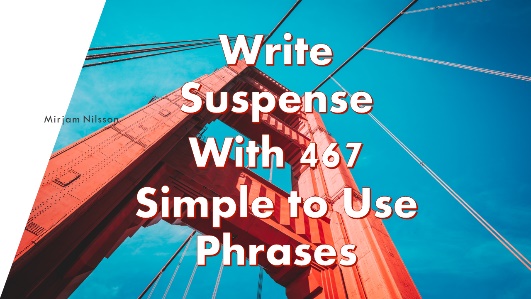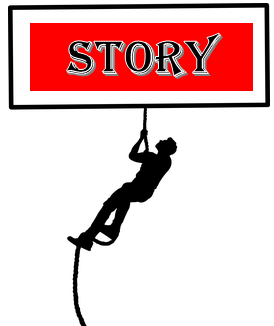
Why Write Suspense
Write Suspense to boost tension. Donald Mass in his book Writing the Breakout Novel declares we should have tension on every page. When John and I first heard him say that at a seminar, we asked ourselves how could we do that?
If you are asking yourself the same question, grab a chair and keep reading. We will show you several ways to increase tension on every page, using suspense and anticipation.
Write Suspense to Add Punch
When you plan your novel, you probably think of several exciting events. Writers call these plot points. These thrilling scenes are full of tension.
The question is how do you create tension between your plot points? That’s what this post will to show you.
When readers anticipates something is going to happen, they get involved and stay involved in your story looking forward to the next event.
Without your reader’s expectation that something major is going to happen, the climax you have planned will have little impact.
Let’s Dive In
Anticipation Reveals Character
Here’s our first point.
Your character’s expectations shape their behavior.
Personality is revealed by their reaction to the upcoming event. If they imagine pain or danger, they will figure out a way to prevent it. If they imagine success, they will put time and effort into making it happen.
Anticipation generates many different emotions, some of them conflicting. Communicate these feelings using your character’s actions, or lack of action, verbal and internal dialog.
Capture the energy of anticipation and put that energy into words. That’s how you write suspense.
Give details about your character’s preparation for an upcoming event. How does your antagonist or protagonist prepare for the imminent challenge?
Include Character’s Thoughts
Brief thoughts will not be effective. Create a train of thoughts or actions. This allows your reader to truly understand what your characters are thinking and feeling.
Explain your character’s motivation. Why are they reacting this way? Anything that will increase the anxiety.
The more your reader knows the more invested they will be in the outcome. Your reader will be curious if the result will be what your character imagines or something completely different.
See our post: Writing Anxiety with easy to use phrases.
Here is a case in point. Let’s say the event (plot point) you are planning is a romantic encounter:
You write about the girl’s anticipation. She excitedly talks to her girlfriend. She prepares by searching her wardrobe for the perfect outfit. Maybe trying on several sets of clothes before deciding. She must choose how to wear her hair (up or down). Her makeup needs to be perfect. She frets about everything.
On the other hand, the man must decide where to take her on the date. Which tie to wear. Should he buy flowers? Maybe roses or something less formal, like daisies.
All this preparation and anxiousness prepares your reader for the event. If done right your reader, like your characters, will be hoping for the best.
And yet a part of us knows; nothing ever happens like we expect. This leads to curiosity and suspense.
Will things go as planned or veer off in a completely new direction?
Observing the anxious planning, allows your reader to become involved with what happens. The main purpose for writing about anticipation is to make your readers care.
The emotional groundwork you build should lead to something significant (a plot point, a turning point, or a major shift in a relationship).
Expectations instantly add an extra dose of suspense
Write Suspense to Hold Your Story Together
Suspense and anticipation are the glue that connects your major events. As your characters prepare or refuse to prepare for an upcoming plot point, your reader feels the tension mount.
Allow your readers to get to know your characters through their excitement or their fear. Strong emotions keep your readers engrossed in your story and curious about your character’s future.
See our post about Writing Fear with Easy to Use phrases
Your reader’s curiosity builds from open ended possibilities. Explain what could happen if certain tasks are not completed. You must arouse excitement or curiosity about the outcome.
You want your readers eager and inquisitive about what will ultimately happen to your character. In other words, you want your readers to care.
Get Ready for a Change
Once the event occurs the suspense or anticipation is over. Show what happens after the event.
- How does the event change your characters?
- Do they change directions?
- Do they gain a new perspective?
- Discover insights about themselves?
Remember each event (plot point) should produce both internal and external changes.
The plot point must change your characters, or why is the event in the story? Each event should have an emotional impact on your characters.

Obviously, as soon as the event happens you need to begin moving forward to the next event.
Use suspense or anticipation to connect your plot points so one event leads to the next. Show your readers how each move your character makes leads to the next important event.
- What does your character speculate will happen next?
- What outcome do they desire most?
- What do they fear most?
- What new assumptions have they made?
Timing is Everything
Consider this: time is the obstacle when you write suspense.
You can create tension by conveying a strong sense of time. Your character will desire to either slow down or speed up time.
Your character may be impatient, wanting something to happen quicker, or anxious, hoping they had more time. Either way, time can create tension.
Something often overlooked. You can keep your reader aware of the time factor by physical actions. Let your character check their watch or look at the clock. Maybe mark off the days on a calendar. Those actions will build a sense of urgency.
Urgency will grab your reader’s attention
Create urgency. Set a time by which your main character must complete a task. Then take your reader to the edge of that time limit.
Think about this. Your antagonist can demand a time limit. Something terrible will happen at sunset (or noon). The bomb will explode, or the hostage killed, in two hours.
Pacing Suspense
Writing suspense and anticipation has the peculiar ability to slow time. When we anticipate something, time seems to stop. Remember Christmas or your birthday when you were a child? Did you feel like they would never come?
These breaks between exciting plot points are the perfect time to zoom in on small, powerful details. Depict multiple emotions to immerse your readers in your story.
- Use vivid sensory language (sites, sounds, taste, touch, and smells)
- Linger on or magnify important details.
- Breathe life into the moment.
- Think about details that will enhance your reader’s experience.
Stretch out your scene. Slow the action. Engage your readers in the moment. Well-crafted anticipation will turn your audience from observers to participants.
You want your readers holding their breath anxiously Waiting
When you write the scene with the event, increase the pace with shorter sentences and paragraphs. The change in tempo will increase your reader’s tension.
See our Post: How to Pace Your Story
Write Suspense to Pull Your Readers Into Your Story
Your main character’s internal conflicts will create either suspense or anticipation. The excitement or uncertainty will make your readers curious about the choices your character will make.
It is essential to capture your reader’s heart. You want your character’s concerns to become your reader’s concerns.
A reader’s capacity to imagine possible outcomes harnesses their tension. Suspense relies on uncertainty, while anticipation comes from expectation.
Both anticipation and suspense require curiosity on the part of your reader. These emerge out of your reader’s identification with your character.
A reader’s capacity to imagine possible outcomes harnesses their tension. Suspense relies on uncertainty, while anticipation comes from expectation.
The key is to engage your reader in the emotional upheaval of the anticipated event.
You have the power to build tension as you pepper the scenes leading up to a plot point with your character’s emotions.
Emotions are a major part of getting to know your character. Your character’s emotions are your reader’s guide to their own feelings. Create emotions your reader connects with.
Consider the Order for Revealing the Next Event
Both the ordering of events and the pace should allow suspense to develop throughout your story. Try to link the anticipation or suspense with high stakes. Give your characters something huge to gain or to lose.
Relate other factors.
- Are there conflicting subconscious motives?
- Why does your character anticipate a certain outcome?
- Why does it matter to them?
- What does your character long for in the depth of their soul?
- Has self-doubt flexed its muscles?
See this post for more ideas: https://kidlit.com/storytelling/
The mixed flow of emotions should be arresting. Lubricate your story with emotions.
Write Suspense with Foreshadowing
Foreshadowing will amplify the tension between plot points.
Hinting at a future development engages your reader’s curiosity.
Foreshadowing creates an atmosphere of suspense, making the reader anxious to learn more.
Tease your reader. Drop small hints about something that will impact your story later. Plant seeds about an upcoming event. Your readers will look forward to those seeds bearing fruit.
Foreshadowing is a subtle way to write suspense or build anticipation in the minds of your reader. It adds dramatic tension to your story.
Put another way, help your readers develop expectations. Specifically, create questions. Questions are central to creating both anticipation and suspense. Develop curiosity.
Check out our post about Foreshadowing
Build Tension to the End
Let’s take it a step further. Be sure to hint, at a showdown between your main character and your antagonist. Suggest a moment when your story’s forces will collide.
Your reader wants your main character to succeed, they also want the villain to fail and suffer the consequences.
This anticipated confrontation will Keep your reader wondering how the story could possibly workout. How will your hero win and deal justice to those who got in his way?
Write suspense that will keep your reader anxiously moving forward.
See the article: Build Toward The Story’s End
Remember, anticipation must be built in layers. The best tension rises when it increases gradually.
Let’s Wrap it Up
Anticipation and suspense are magical feelings. Now you have the tools to use these devises in your writing.
The power comes from making your audience care about your characters and wonder what will happen next.
You want your reader invested, wondering whether things will go as planned or veer off in a different direction.
Remember, the anticipated showdown between your hero and your villain will keep your reader glued to your pages until the very end.
Your Readers are waiting. So let’s go to work.
Can you think of other ways to write suspense or anticipation?
Can you see how anticipation and suspense create tension between your plot points?
We have created a list of words and phrases we hope will help you write suspense using anticipation.
Did you enjoy out post?. Please share it with your friends
Happy Writing
John& Patty @writingagreatbook.com 2023










